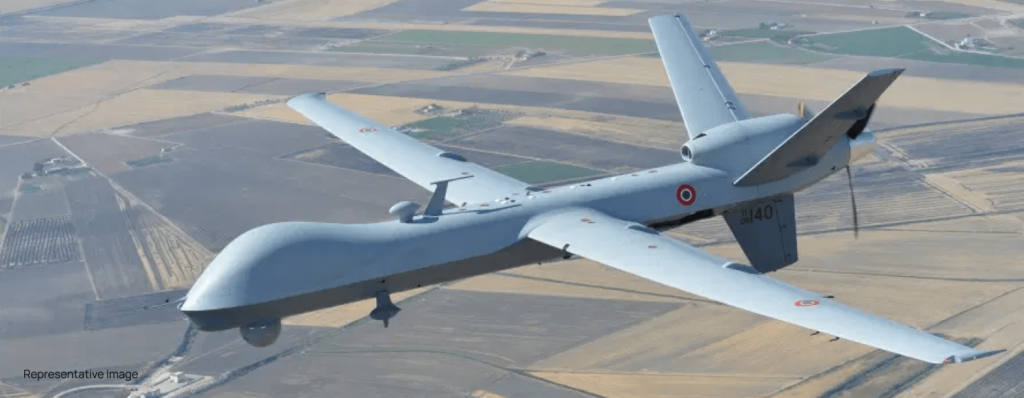
- India has made tremendous strides in the development of unmanned aerial vehicles (UAVs), which are used for tactical operations, combat missions, surveillance, and reconnaissance.
- Fortifying defence connections with European countries and bolstering surveillance and reconnaissance activities would further bolster India’s geopolitical power and improve its defence readiness.
- Domestic drone programs in India are faced with some issues, including technological gaps such as improved sensors, downsizing, and AI integration for autonomous operations.
India has made significant investments in the development of its own drone and UAV technologies. The government has approved ₹120 crore for three years under the Production-Linked Incentive Scheme to provide a 20% value addition incentive to encourage domestic drone manufacture. Additionally, the majority of the 2024–25 defence budget of ₹5.94 lakh crore is allocated to domestic UAV projects like Ghatak and Rustom. The Agri-Infra Fund provides farmers with up to 50% subsidies to support drone technologies in agriculture. An additional ₹200 crore would be spent on a Digital Sky Platform to keep an eye on drones and guarantee airspace compliance. The Drone Shakti Initiative, which is part of Startup India, receives ₹2,000 crore a year to help the government become self-sufficient.
The Eurodrone program and India’s ties with European countries like Germany, France, and Italy may extend beyond strategic considerations to include strong scientific and economic ties. The program’s objective is to create next-generation MALE UAVs for reconnaissance and surveillance. India would have access to cutting-edge technologies including improved surveillance sensors, AI-powered autonomous systems, and state-of-the-art avionics by joining Eurodrone. This partnership would accelerate the development of local UAV technologies while strengthening India’s defence capabilities and providing beneficial knowledge transfer.
Fortifying defence connections with European countries and bolstering surveillance and reconnaissance activities would further bolster India’s geopolitical power and improve its defence readiness. Economically speaking, it would also boost India’s UAV manufacturing industry, which would lead to innovation and job prospects. To ensure that involvement does not jeopardize long-term self-reliance goals in UAV manufacturing, it is crucial to strike a balance between integrating foreign technology and local UAV ambitions.
Eurodrone is important because it gives India access to advanced technology, bolsters its defence capabilities, and encourages innovation and cooperation with Europe.
Types of UAVs in India
India has made tremendous strides in the development of unmanned aerial vehicles (UAVs), which are used for tactical operations, combat missions, surveillance, and reconnaissance. The different UAVs employed in India are briefly described in this section, with an emphasis on their distinctive technological characteristics:
1. Micro or Miniature Aerial Vehicles (MAVs): Designed for short-range and lightweight applications, MAVs are mini-UAVs having a wingspan or length of less than two meters. Their primary functions include tactical operations, reconnaissance, and observation. The Netra UAV, created by DRDO and intended for challenging situations like urban combat, is one such example. Another such is IdeaForge’s Switch, a small MAV that Indian security forces frequently utilize for urban monitoring.
2. Nano-Aerial Vehicles (NAVs): Weighing less than 250 grams and having a wingspan of less than one meter, NAVs are the smallest class of UAVs. These are employed in tactical missions, clandestine operations, and reconnaissance. With a primary focus on military and confined area search and rescue missions, DRDO is creating Nano UAVs.
3. Vertical Take-Off and Landing (VTOL) UAVs: These unmanned aerial vehicles (UAVs) can take off and land vertically, providing them significant flexibility in areas without a conventional runway or in confined locations. IdeaForge’s Defender is employed for border patrols and law enforcement tasks, whereas DRDO’s Rustom-H (VTOL Variant) is for high-end security surveillance in rough terrain.
4. LASE UAVs: Typically, LASE UAVs are deployed for brief missions at extremely low altitudes. In emergency response tasks, these aircraft are mostly used for combat reconnaissance and tactical surveillance. Small UAV systems tailored for short-duration tasks are being developed by DRDO. Small UAVs are also available from Skylark Drones in Pune for comparable tactical military missions.
5. Low Altitude, Long Endurance, or LALE UAVs: LALE UAVs are ideal for long-term surveillance over large areas because they were designed for low altitude yet prolonged use. The Rustom UAV from DRDO, which is mostly utilized in border areas for long-endurance surveillance, is a prime example of this.
6. MALE UAVs (Long Endurance, Medium Altitude): Up to 30,000 feet is the maximum altitude at which a male UAV may operate, providing extended endurance for border patrol, surveillance, and reconnaissance. To give one example, consider DRDO’s Rustom-2, which can remain in the air for over twenty-four hours. Additionally employed for combat operations and border monitoring are Heron and Predator UAVs, which were purchased from the United States.
The Indian Armed Forces operate a variety of UAVs, each designed for specific missions, including surveillance, reconnaissance, and tactical operations. Here’s a detailed breakdown of these UAVs, focusing on their technical features, including sensors, electronic warfare capabilities, engines, communication systems, and flight durations:
- Rustom-2 (MALE UAV): In general, the Rustom-2 MALE UAV is employed for surveillance and reconnaissance tasks, primarily for intelligence collection, border patrol, and long-term observation of large areas. It is equipped with synthetic aperture radar (SAR), signals intelligence (SIGINT) devices, and high-resolution electro-optical/infrared (EO/IR) cameras. The UAV is powered by a turboprop engine, which allows it to reach altitudes of up to 30,000 feet and fly for up to 24 hours. Because the Rustom-2 may be launched from airfields or ground-based platforms, its deployment options are varied. Satellite communication (SATCOM) and line-of-sight systems for real-time data transmission help it communicate.
- Netra UAV (MAV): Tactical surveillance uses the Netra MAV for intelligence gathering and reconnaissance in limited spaces or complex surroundings. It has a flight endurance of roughly one to two hours, can include EO/IR sensors, and is suitable for clandestine mission operations. Communication systems use radio frequency (RF) for short-range operations. They are powered by electric motors and are very light, requiring manual or basic small platform mobility.
- Switch MAV (IdeaForge): Switch MAVs are intended for tactical observation, particularly in confined spaces where conventional aircraft would not be able to function. It has thermal imaging systems and EO/IR sensors for efficient surveillance in urban and low-light environments. The UAV is perfect for short reconnaissance missions because of its 30- to 60-minute flying time. It is powered by electric motors, runs quietly, and can be started manually or with a small, portable system. It communicates via Wi-Fi and radio frequency for telemetry and real-time video streams.
- Heron UAV (MALE UAV): The Heron UAV is designed for tactical reconnaissance, long-range surveillance, and battlefield control, primarily in border regions. For all-weather, day-and-night surveillance, it is equipped with SAR, EO/IR, and SIGINT sensors. With a piston engine that provides exceptional fuel efficiency, the UAV can fly for up to 24 hours and reach 30,000 feet. Airfields are used to launch the Heron. Either traditional runways or even unconventional runways are used for its launch. Line-of-sight systems and secure satellites are used to maintain communication. Data is transferred in real-time.
- Predator UAVs (MQ-9 Reaper): The MQ-9 Reaper, a Predator UAV, may be used for both precision strike and reconnaissance operations. It has synthetic aperture radar, SAR, and EO/IR cameras for round-the-clock monitoring in all weather. The UAV’s turboprop engine allows it to stay in the air for more than 24 hours and reach altitudes of up to 50,000 feet. The UAV Predator can be launched from forward or remote operating bases, although it is usually launched from conventional runways. It features line-of-sight communication for safe data transfer and worldwide coverage, SATCOM for communications, and anti-jamming.
- Searcher UAV (IAI): The Searcher UAV is employed in battlefield management and long-range surveillance, particularly for military operations and intelligence collection. It can fly for up to 24 hours and is equipped with EO/IR cameras and SAR, which enable it to continuously survey the area in any situation. Searcher is often launched from a standard airport or ground-based platform and has a piston engine for optimal fuel efficiency. It uses line-of-sight and satellite technology to ensure a secure connection.
- Puma and Wasp NAVs: These tiny UAVs are used for surveillance and clandestine tactical operations in challenging situations, like cities. They can collect intelligence in real time since they are outfitted with thermal imaging equipment and high-definition cameras. Their typical flight duration is one to two hours, which is sufficient for brief, clandestine missions. These electric motor-powered UAVs are incredibly portable due to their ability to be hand-launched and operate silently. For short-range operations, Wi-Fi and radio frequencies are used to manage communication.
India is creating several cutting-edge UAVs for electronic warfare, precision strikes, surveillance, and reconnaissance.
1. Rustom-2 (TAPAS-BH-201): The male unmanned aerial vehicle (UAV) DRDO Rustom-2 (TAPAS-BH-201) will be equipped with a turbojet engine to increase its flying duration. For intelligence collection and reconnaissance, the UAV will be equipped with EO/IR cameras, SAR, and SIGINT sensors.
2. DRDO Ghatak UCAV: Designed for precision strikes, the Ghatak is a stealth drone. It can carry out air-to-ground missiles and is appropriate for electronic warfare in terms of jamming and communication interruption. It is also outfitted with sophisticated targeting systems.
3. CATS Infinity: The high-altitude pseudo-satellite HAL Combat Air Teaming System, CATS Infinity, can remain in the air for extended periods using solar power. It is equipped with hyperspectral sensors to improve surveillance and support electronic warfare by jamming and providing situational awareness.
4. Archer UAV: This drone is intended for precision strikes and ISR (Intelligence, Surveillance, and Reconnaissance). It can carry ATGMs and laser-guided rockets and is outfitted with EO/IR sensors and targeting systems. Additionally, it facilitates electronic warfare by jamming payloads.
Challenges for India’s Indigenous Drone Programs
Domestic drone programs in India are faced with some issues, including technological gaps such as improved sensors, downsizing, and AI integration for autonomous operations. The regulatory issues that need clearer regulations include airspace management and UAV integration into national systems, and export restrictions restricting access to cutting-edge technologies. While dependability issues necessitate improvements in battery life and performance in challenging environmental circumstances, the high expenses of developing state-of-the-art UAV technology provide financial constraints.
Conclusion
India’s UAV and drone technologies have advanced significantly because of large expenditures from the public and commercial sectors. The nation is moving toward increased self-sufficiency in UAV production and defence capabilities thanks to programs like the Production-Linked Incentive Scheme, the Drone Shakti Initiative, and partnerships with European nations like Germany, France, and Italy. India is quickly establishing itself as a major force in the UAV industry worldwide. The Indian Defence Ministry has been pushing businesses to create top-notch UAVs for uses like precision attacks and tactical monitoring. There are still many gaps to cover with these innovations, including technological gaps, regulatory hurdles, and financial constraints. Continuous efforts at research, collaboration, and development would overcome such obstacles, enabling India to lead UAV technology that improves defence readiness as well as fosters economic growth.
References:
- https://www.shephardmedia.com/news/air-warfare/india-officially-welcomed-as-observer-on-eurodrone-programme
- https://alphadefense.in/index.php/2024/11/04/indias-path-to-drone-self-reliance-why-indigenous-uav-development-is-essential/
- https://www.e-education.psu.edu/geog892/node/5
- https://www.india.com/news/ghatak-ucav-ade-drdo-defence-research-and-development-organisation-pm-modi-indian-army-pakistan-aitcraft-tejas-mig-su-30mki-7382382
- https://ideaforgetech.com
Piyush Anand is a Biotechnology Engineering student at Chandigarh University. His primary interest lies in International Affairs, Defence and Strategy. Views expressed are the author’s own.
